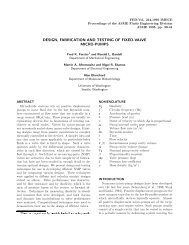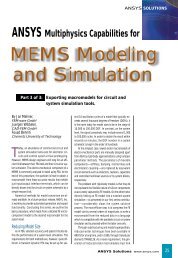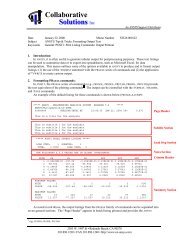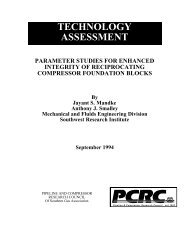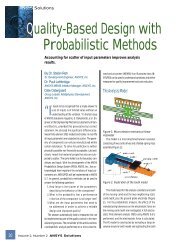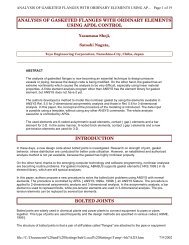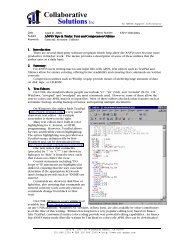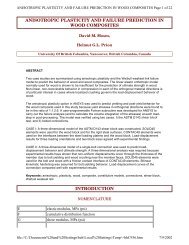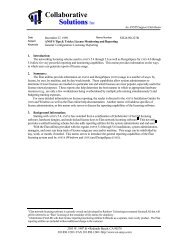Visualizing structural matrices in ANSYS using APDL - ANSYS Users
Visualizing structural matrices in ANSYS using APDL - ANSYS Users
Visualizing structural matrices in ANSYS using APDL - ANSYS Users
You also want an ePaper? Increase the reach of your titles
YUMPU automatically turns print PDFs into web optimized ePapers that Google loves.
<strong>Visualiz<strong>in</strong>g</strong> <strong>structural</strong> <strong>matrices</strong> <strong>in</strong> <strong>ANSYS</strong> us<strong>in</strong>g <strong>APDL</strong><br />
Aaron C Acton<br />
19 November 2008<br />
Abstract<br />
This article presents a method of visualiz<strong>in</strong>g <strong>structural</strong> <strong>matrices</strong> used <strong>in</strong> f<strong>in</strong>ite-element analysis us<strong>in</strong>g <strong>ANSYS</strong><br />
and the <strong>ANSYS</strong> Parametric Design Language (<strong>APDL</strong>). The <strong>in</strong>formation is <strong>in</strong>tended to provide some <strong>in</strong>sight <strong>in</strong>to<br />
the nature of <strong>structural</strong> <strong>matrices</strong> used <strong>in</strong> f<strong>in</strong>ite-element codes. Some terms used <strong>in</strong> sparse-matrix arithmetic are<br />
discussed, and methods for calculat<strong>in</strong>g certa<strong>in</strong> quantities are provided. A test model is constructed to demonstrate<br />
how the stiffness, mass, and damp<strong>in</strong>g <strong>matrices</strong> may be visualized for various systems. The effect of element<br />
shape, element type (<strong>in</strong>clud<strong>in</strong>g superelements), element reorder<strong>in</strong>g, and equation reorder<strong>in</strong>g on <strong>structural</strong> <strong>matrices</strong><br />
is briefly <strong>in</strong>vestigated.<br />
Keywords: Pott<strong>in</strong>g <strong>matrices</strong>, <strong>APDL</strong>, HBMAT, Ill condition<strong>in</strong>g, Matrix condition<br />
Tested <strong>in</strong>: <strong>ANSYS</strong> 11.0<br />
1 Introduction<br />
Modern f<strong>in</strong>ite-element codes have become advanced<br />
tools that largely remove the user from <strong>in</strong>ternal calculations,<br />
but some users may be <strong>in</strong>terested to learn more<br />
about the nature of the mathematics performed by the<br />
code. The ma<strong>in</strong> purpose of this article is to provide<br />
a visualization of some of the <strong>matrices</strong> used dur<strong>in</strong>g the<br />
solution of a <strong>structural</strong> f<strong>in</strong>ite-element analysis with AN-<br />
SYS. Where appropriate, a brief note about a variety<br />
of topics will be presented to aid <strong>in</strong> the explanation of<br />
the images. All <strong>in</strong>put files used to produce the images<br />
have been provided <strong>in</strong> the appendices.<br />
2 Graphical Output of Structural Matrices<br />
<strong>ANSYS</strong> offers two methods of writ<strong>in</strong>g the <strong>structural</strong><br />
<strong>matrices</strong> to a pla<strong>in</strong>-text file; the first method uses the<br />
HBMAT command <strong>in</strong> the /AUX2 processor, while the second<br />
uses a debugg<strong>in</strong>g option <strong>in</strong> the Solve_Info field<br />
of the BCSOPTION command. Matrix <strong>in</strong>formation obta<strong>in</strong>ed<br />
with HBMAT is written accord<strong>in</strong>g to the Harwell-<br />
Boe<strong>in</strong>g standard, a general format that takes advantage<br />
of the sparseness of typical <strong>structural</strong> <strong>matrices</strong>. Details<br />
of the standard, <strong>in</strong> addition to several examples, were<br />
presented by Duff, Grimes, and Lewis [1].<br />
The macro used to plot the <strong>matrices</strong> for this ar-<br />
ticle (available <strong>in</strong> Appendix A.6) uses the matrix <strong>in</strong>formation<br />
from a Harwell-Boe<strong>in</strong>g matrix file (assembled<br />
global matrix from jobname.full or superelement<br />
matrix file from jobname.sub) or a BCS matrix file.<br />
The nonzero terms are each represented by a s<strong>in</strong>gle, 4node,<br />
planar, <strong>structural</strong> element, arbitrarily chosen as<br />
PLANE182, although other types of elements could have<br />
been used. A body force is assigned to each element us<strong>in</strong>g<br />
the BFE,,TEMP command, allow<strong>in</strong>g the magnitude<br />
of the coefficients to be represented by a coloured contour<br />
plot (EPLOT with /PBF,TEMP,,1), such as the one<br />
<strong>in</strong> Figure 1.<br />
Figure 1: Stiffness matrix plot show<strong>in</strong>g contours proportional<br />
to nonzero coefficient value.
A. C. Acton / <strong>Visualiz<strong>in</strong>g</strong> <strong>structural</strong> <strong>matrices</strong> <strong>in</strong> <strong>ANSYS</strong> us<strong>in</strong>g <strong>APDL</strong> 2<br />
S<strong>in</strong>ce the magnitudes of the coefficients can vary by<br />
many orders of magnitude, a logarithmic plot was obta<strong>in</strong>ed<br />
by tak<strong>in</strong>g the base-10 logarithm of the absolute<br />
value of each coefficient, log 10(abs(val)).<br />
The follow<strong>in</strong>g <strong>in</strong>formation was added to each plot:<br />
• matrix type (stiffness, damp<strong>in</strong>g, mass),<br />
• element type with keyoptions where appropriate,<br />
• matrix file,<br />
• matrix symmetry,<br />
• number of nonzero terms (NZ),<br />
• number of equations (EQN),<br />
• matrix sparseness (% Sparse), and<br />
• matrix condition number (COND).<br />
Furthermore, if the effect of element sort<strong>in</strong>g was of <strong>in</strong>terest<br />
(discussed <strong>in</strong> Section 6), the follow<strong>in</strong>g was added:<br />
• element sort<strong>in</strong>g direction (WSORT),<br />
• maximum wavefront (WMAX), and<br />
• root-mean-square wavefront (WRMS).<br />
Alternatively, if the effect of equation reorder<strong>in</strong>g was<br />
of <strong>in</strong>terest (discussed <strong>in</strong> Section 7), the follow<strong>in</strong>g was<br />
added:<br />
• equation reorder<strong>in</strong>g scheme.<br />
The mean<strong>in</strong>g of these terms is discussed <strong>in</strong> the follow<strong>in</strong>g<br />
sections.<br />
2.1 Number of Nonzero Terms<br />
While the frontal solver uses the full stiffness matrix to<br />
perform Gaussian elim<strong>in</strong>ation, the Boe<strong>in</strong>g Sparse solver<br />
was designed to handle only the nonzero entries, tak<strong>in</strong>g<br />
advantage of the fact that <strong>structural</strong> <strong>matrices</strong> are typically<br />
sparsely populated [2]. In addition, many <strong>structural</strong><br />
problems result <strong>in</strong> <strong>matrices</strong> that are symmetric<br />
about the diagonal, allow<strong>in</strong>g for further optimization<br />
of the solution algorithms. When the system equations<br />
are symmetric, only one triangular portion of the <strong>matrices</strong><br />
need to be stored. Consequently, the output from<br />
HBMAT may conta<strong>in</strong> only half of the off-diagonal terms.<br />
The output from the HBMAT command may not accurately<br />
report the number of nonzero terms <strong>in</strong> the<br />
matrix; when dump<strong>in</strong>g matrix <strong>in</strong>formation from the<br />
jobname.sub file, all terms <strong>in</strong> the full matrix are written,<br />
<strong>in</strong>clud<strong>in</strong>g the zero term. For this reason, the macro<br />
provided with this article removes the nonzero terms<br />
from the array of numerical values, then counts the<br />
number of diagonal and off-diagonal terms. When the<br />
matrix is symmetric, the number of nonzero terms <strong>in</strong><br />
the full matrix is calculated as<br />
NNZ = 2 × ODNZ + DINZ ,<br />
where ODNZ is the number of off-diagonal nonzero<br />
terms and DINZ the number of diagonal nonzero terms.<br />
Otherwise, <strong>in</strong> the case of an unsymmetric matrix,<br />
NNZ = ODNZ + DINZ .<br />
The nonzero terms reported by the supplied macro <strong>in</strong><br />
this article represents the total number of nonzero terms<br />
<strong>in</strong> the full matrix.<br />
2.2 Number of Equations<br />
There will generally be more degrees of freedom (DOF)<br />
<strong>in</strong> a model than equations <strong>in</strong> the system s<strong>in</strong>ce some may<br />
be condensed out before the <strong>matrices</strong> are written with<br />
HBMAT. The follow<strong>in</strong>g situations <strong>in</strong>dicate when certa<strong>in</strong><br />
DOF are not written to the matrix file with HBMAT:<br />
• When constra<strong>in</strong>ts (D) are specified <strong>in</strong> the model,<br />
the rows and columns correspond<strong>in</strong>g to these<br />
DOF are elim<strong>in</strong>ated from the system of equations.<br />
• When coupled sets (CP) and/or constra<strong>in</strong>t equations<br />
(CE) are present, the rows and columns correspond<strong>in</strong>g<br />
to the slave DOF are elim<strong>in</strong>ated from<br />
the system of equations.<br />
The number of equations reported by the macro provided<br />
with this article is simply the number of rows <strong>in</strong><br />
the file written with HBMAT.<br />
2.3 Matrix Sparseness<br />
S<strong>in</strong>ce typical <strong>structural</strong> <strong>matrices</strong> are said to be sparse,<br />
it may be of <strong>in</strong>terest to calculate some measure of the<br />
sparseness, which is generally represented by the percentage<br />
of zero terms <strong>in</strong> the matrix. Us<strong>in</strong>g the def<strong>in</strong>ition<br />
of NNZ <strong>in</strong> section 2.1, the sparseness is calculated as<br />
sparseness =<br />
or, s<strong>in</strong>ce the matrix is square,<br />
sparseness =<br />
<br />
<br />
NNZ<br />
1 −<br />
× 100% ,<br />
NROW × NCOL<br />
<br />
1 − NNZ<br />
NROW2 <br />
× 100% ,<br />
where NROW and NCOL are the number of rows and<br />
columns reported by HBMAT, respectively.
A. C. Acton / <strong>Visualiz<strong>in</strong>g</strong> <strong>structural</strong> <strong>matrices</strong> <strong>in</strong> <strong>ANSYS</strong> us<strong>in</strong>g <strong>APDL</strong> 3<br />
2.4 Matrix Condition<br />
The condition number of a matrix is a measure of how<br />
sensitive a solution is to numerical errors. A matrix<br />
with a condition number close to unity is said to be well<br />
conditioned, while that with a large condition number is<br />
said to be ill conditioned. This topic has been covered<br />
elsewhere [3].<br />
The condition number can be computed <strong>in</strong> several<br />
different ways, but the method used by the macro provided<br />
with this article calculates the ratio of largest to<br />
smallest pivot values (known as the condition number<br />
<strong>in</strong> the two-norm), which can be obta<strong>in</strong>ed directly from<br />
the jobname.DIAG file.<br />
3 F<strong>in</strong>ite Element Test Model<br />
S<strong>in</strong>ce the effect of geometry on the matrix structure<br />
was not of <strong>in</strong>terest <strong>in</strong> this article, the rectangular block<br />
shown <strong>in</strong> Figure 2 was used for all tests. In most<br />
cases, the geometry was meshed with hexahedrons,<br />
while tetrahedrons were used <strong>in</strong> others (images shown<br />
later).<br />
Figure 2: Rectangular volume used for test models.<br />
Three faces of the volume were constra<strong>in</strong>ed normal<br />
to the surface, and one of these faces was constra<strong>in</strong>ed for<br />
non-<strong>structural</strong> degrees of freedom (see Appendix A.1).<br />
When used <strong>in</strong> a substructur<strong>in</strong>g analysis, all DOF for<br />
external nodes were selected as masters. While additional<br />
details on substructur<strong>in</strong>g can be found <strong>in</strong> the<br />
Advanced Analysis Techniques Guide [4], a short note<br />
on substructur<strong>in</strong>g is <strong>in</strong>cluded here.<br />
3.1 Substructur<strong>in</strong>g<br />
A substructure analysis (ANTYPE,SUBSTR) uses a technique<br />
to reduce the system <strong>matrices</strong> to a smaller set of<br />
DOF [2]. Internal DOF that have no applied loads or<br />
boundary conditions, and those that will not be coupled<br />
to other parts of the model, are condensed out of<br />
the system <strong>matrices</strong>. As described by Bathe, “a substructure<br />
is used <strong>in</strong> the same way as an <strong>in</strong>dividual f<strong>in</strong>ite<br />
element with <strong>in</strong>ternal degrees of freedom that are statically<br />
condensed out prior to the element assemblage<br />
process” [5]. It is expected, then, that the substructure<br />
matrix has less DOF and is more densely populated<br />
than the assembled global matrix.<br />
4 Matrix Type<br />
The macro provided <strong>in</strong> this article supports the plott<strong>in</strong>g<br />
of real-value coefficients for stiffness, damp<strong>in</strong>g,<br />
consistent-mass, and lumped-mass <strong>matrices</strong> from the<br />
Harwell-Boe<strong>in</strong>g file or from the BCS file. In the follow<strong>in</strong>g<br />
sections, the structure of these <strong>matrices</strong> will be<br />
<strong>in</strong>vestigated.<br />
The stiffness matrix is perhaps the most <strong>in</strong>terest<strong>in</strong>g<br />
to <strong>in</strong>vestigate as the effect of element shape and element<br />
type can be immediately seen.<br />
4.1 Stiffness Matrix<br />
Depend<strong>in</strong>g on the shape of the geometry be<strong>in</strong>g meshed,<br />
one may decide to choose either hexahedrons (also<br />
called bricks), tetrahedrons (also called tets), or some<br />
comb<strong>in</strong>ation thereof, fill<strong>in</strong>g <strong>in</strong> nonconformities with<br />
prisms and pyramids where necessary. The mesh and<br />
stiffness matrix for a simple model consist<strong>in</strong>g purely of<br />
hexahedrons can be seen <strong>in</strong> Figure 3.<br />
Figure 3: Mesh and associated stiffness matrix for hexahedral<br />
elements.
A. C. Acton / <strong>Visualiz<strong>in</strong>g</strong> <strong>structural</strong> <strong>matrices</strong> <strong>in</strong> <strong>ANSYS</strong> us<strong>in</strong>g <strong>APDL</strong> 4<br />
In contrast, Figure 4 shows the mesh and stiffness<br />
matrix for the same geometry meshed with tetrahedrons<br />
(element edge length kept constant).<br />
Figure 4: Mesh and associated stiffness matrix for tetrahedral<br />
elements.<br />
It is worth not<strong>in</strong>g here that us<strong>in</strong>g tets <strong>in</strong> place of<br />
bricks with equal element edge length has a significant<br />
effect on the number of nonzero terms. In addition, the<br />
estimated maximum value for wavefront size <strong>in</strong>creased<br />
from 57 to 87 for this model (the topic of wavefront will<br />
be discussed further <strong>in</strong> Section 6).<br />
If the brick model is solved as a regular superelement<br />
(Guyan reduction) with master DOF set accord<strong>in</strong>g<br />
to the specifications described <strong>in</strong> Section 3, the result<strong>in</strong>g<br />
stiffness matrix becomes dense, as shown <strong>in</strong> Figure<br />
5.<br />
Figure 5: Stiffness matrix for regular (Guyan reduction)<br />
superelement.<br />
The number of nonzero terms <strong>in</strong>creases substantially,<br />
and the number of equations decreases, caus<strong>in</strong>g<br />
the sparseness to drop to near zero. The estimated<br />
wavefront has also <strong>in</strong>creased significantly.<br />
Us<strong>in</strong>g component-mode synthesis (CMS) rather<br />
than Guyan reduction results <strong>in</strong> the stiffness matrix<br />
shown <strong>in</strong> Figure 6.<br />
Figure 6: Stiffness matrix for CMS superelement.<br />
Here, the sparseness <strong>in</strong>creases over that for regular<br />
superelements, for which the “tail” <strong>in</strong> the lower-right<br />
corner is largely responsible.<br />
4.2 Mass Matrix<br />
The typical formation of the <strong>structural</strong> mass matrix <strong>in</strong><br />
implicit analyses creates coupl<strong>in</strong>g between degrees of<br />
freedom. This is known as consistent mass, and can be<br />
seen <strong>in</strong> Figure 7.<br />
Figure 7: Consistent-mass matrix from the FULL file.<br />
Alternatively, it may be desirable to diagonalize the<br />
mass matrix by concentrat<strong>in</strong>g the mass at the nodes<br />
(LUMPM,ON), such as <strong>in</strong> the case of a transient analysis<br />
us<strong>in</strong>g explicit time <strong>in</strong>tegration, for which an <strong>in</strong>expensive<br />
matrix <strong>in</strong>version is highly beneficial. The effect
A. C. Acton / <strong>Visualiz<strong>in</strong>g</strong> <strong>structural</strong> <strong>matrices</strong> <strong>in</strong> <strong>ANSYS</strong> us<strong>in</strong>g <strong>APDL</strong> 5<br />
of this diagonalization becomes immediately apparent<br />
when the mass matrix is plotted with the lump<strong>in</strong>g option<br />
turned on, as shown <strong>in</strong> Figure 8.<br />
Figure 8: Lumped-mass matrix from the FULL file.<br />
It should be noted here that the wavefront quantities<br />
reported on these plots apply only to the stiffness<br />
matrix.<br />
<strong>Users</strong> familiar with Workbench Simulation may observe<br />
that scop<strong>in</strong>g a Po<strong>in</strong>t Mass feature to a large number<br />
of nodes may require a large amount of memory<br />
for the solution. The reason for this becomes apparent<br />
when the mass matrix is plotted for such a model (see<br />
Figure 9).<br />
Figure 9: Consistent-mass matrix from the FULL file<br />
when us<strong>in</strong>g the Po<strong>in</strong>t Mass feature <strong>in</strong> Workbench Simulation.<br />
Additional terms appear <strong>in</strong> the mass matrix to account<br />
for the coupl<strong>in</strong>g between the po<strong>in</strong>t mass and the<br />
nodes to which it is attached. Two workarounds for<br />
this issue are to turn on lumped-mass approximation<br />
(to reduce the mass matrix to the diagonal form) or<br />
to reduce the size of geometry to which the feature is<br />
scoped (to reduce the number of nodes <strong>in</strong>cluded <strong>in</strong> the<br />
feature).<br />
4.3 Damp<strong>in</strong>g Matrix<br />
Damp<strong>in</strong>g is discussed last here as it is typically a factor<br />
of one or both of the stiffness and mass <strong>matrices</strong>.<br />
Figure 10: Alpha-damp<strong>in</strong>g matrix from the FULL file.<br />
Figure 11: Beta-damp<strong>in</strong>g matrix from the FULL file.<br />
S<strong>in</strong>ce alpha damp<strong>in</strong>g (ALPHAD) is a mass-matrix<br />
multiplier, it can be seen <strong>in</strong> Figure 10 that the damp<strong>in</strong>gmatrix<br />
plot resembles the structure of the mass matrix.<br />
[C] = α[M]<br />
Similarly, s<strong>in</strong>ce beta damp<strong>in</strong>g (BETAD) is a stiffnessmatrix<br />
multiplier, it can be seen <strong>in</strong> Figure 11 that<br />
the damp<strong>in</strong>g-matrix plot resembles the structure of the<br />
mass matrix.<br />
[C] = β[K]<br />
Other forms of damp<strong>in</strong>g, such as modal damp<strong>in</strong>g,<br />
damp<strong>in</strong>g ratio, and damp<strong>in</strong>g obta<strong>in</strong>ed with speciality<br />
elements, may produce different plots than the ones<br />
shown above.
A. C. Acton / <strong>Visualiz<strong>in</strong>g</strong> <strong>structural</strong> <strong>matrices</strong> <strong>in</strong> <strong>ANSYS</strong> us<strong>in</strong>g <strong>APDL</strong> 6<br />
5 Element Type<br />
The SOLID185 offers a two formulations applicable for<br />
general f<strong>in</strong>ite-sta<strong>in</strong> deformation. The default puredisplacement<br />
formulation (KEYOPT(6)=0), used for simulat<strong>in</strong>g<br />
compressible materials, solves the standard<br />
static system of equations<br />
[K]{u} = {F }<br />
and forms the stiffness matrix shown <strong>in</strong> Figure 12.<br />
Figure 12: Stiffness matrix for pure-displacement element<br />
formulation.<br />
The mixed u-P formulation (KEYOPT(6)=1), typically<br />
used for simulat<strong>in</strong>g nearly-<strong>in</strong>compressible elastoplastic<br />
or fully-<strong>in</strong>compressible hyperelastic materials,<br />
uses a stiffness matrix of the form<br />
<br />
[Kuu] [KuP ]<br />
[KP u] [KP P ]<br />
<br />
{u}<br />
{ ¯ P }<br />
<br />
=<br />
<br />
{F }<br />
{0}<br />
and forms the stiffness matrix shown <strong>in</strong> Figure 13.<br />
Figure 13: Stiffness matrix for mixed u-P element formulation.<br />
Note that the condition number (discussed <strong>in</strong> Section<br />
2.4) for the pure formulation <strong>in</strong> this example is<br />
<br />
,<br />
close to unity whereas that for the mixed formulation<br />
jumps to 10 13 , <strong>in</strong>dicat<strong>in</strong>g an ill-conditioned matrix.<br />
This likely expla<strong>in</strong>s the requirement that a direct solver<br />
must be used for the mixed formulation [6]. Also, the<br />
number of equations <strong>in</strong>creased due to the <strong>in</strong>clusion of<br />
the hydrostatic pressure.<br />
It is also possible to look at the <strong>structural</strong> <strong>matrices</strong><br />
for some coupled-field elements. The static coupled<br />
equations for a piezoelectric element, for example, is<br />
given by<br />
<br />
[K] [K Z ]<br />
[K Z ] T −[K d ]<br />
<br />
{u}<br />
{V }<br />
<br />
=<br />
<br />
{F }<br />
{L}<br />
which produces the symmetric stiffness matrix shown<br />
<strong>in</strong> Figure 14. (Note that SOLID226 are quadratic elements,<br />
whereas the SOLID185 used earlier were l<strong>in</strong>ear<br />
elements, account<strong>in</strong>g for some of the extra equations.)<br />
Figure 14: Stiffness matrix for piezoelectric elements.<br />
In contrast, the static strongly-coupled equations<br />
for thermoelastic elements is given by<br />
<br />
[K] [K ut ]<br />
[0] [K t ]<br />
<br />
{u}<br />
{T }<br />
<br />
=<br />
<br />
{F }<br />
{Q}<br />
which produces the unsymmetric stiffness matrix shown<br />
<strong>in</strong> Figure 15.<br />
<br />
<br />
,<br />
,
A. C. Acton / <strong>Visualiz<strong>in</strong>g</strong> <strong>structural</strong> <strong>matrices</strong> <strong>in</strong> <strong>ANSYS</strong> us<strong>in</strong>g <strong>APDL</strong> 7<br />
Figure 15: Stiffness matrix for thermoelastic elements.<br />
Note that the weakly-coupled formulation would<br />
produce a symmetric matrix.<br />
6 Element Reorder<strong>in</strong>g<br />
While the performance of the frontal solver<br />
(EQSLV,FRONT) has been surpassed by the multi-frontal<br />
design of the Sparse solver (EQSVL,SPARSE), it is <strong>in</strong>structive<br />
to study the frontal solver as it employs the<br />
relatively straightforward solution technique of Gaussian<br />
elim<strong>in</strong>ation. Dur<strong>in</strong>g the solution of a system, the<br />
number of equations active at any one time is called<br />
the wavefront [2]. Before solvers <strong>in</strong>cluded automatic<br />
element reorder<strong>in</strong>g algorithms, it was important to<br />
manually order the elements <strong>in</strong> an attempt to m<strong>in</strong>imize<br />
the maximum wavefront (representative of the amount<br />
of memory needed for the solution) and the square of<br />
the mean wavefront (representative of the computertime<br />
required for the solution). The <strong>ANSYS</strong> Theory<br />
Reference expla<strong>in</strong>s:<br />
To reduce the maximum wavefront size, the<br />
elements must be ordered so that the element<br />
for which each node is first mentioned<br />
is as close as possible <strong>in</strong> sequence to the element<br />
for which it is mentioned last. In<br />
geometric terms, the elements should be ordered<br />
so that the wavefront sweeps through<br />
the model cont<strong>in</strong>uously from one end to the<br />
other <strong>in</strong> the direction which has the largest<br />
number of nodes [2].<br />
An unsorted mesh of hexahedrons may create a stiffness<br />
matrix like the one <strong>in</strong> Figure 16, which shows a<br />
maximum wavefront of 73.<br />
Figure 16: Unsorted matrix for hex mesh.<br />
One technique of reorder<strong>in</strong>g the elements is to use<br />
geometric sort<strong>in</strong>g (WSORT), for which a sort<strong>in</strong>g direction<br />
can be manually specified. The present topic of plott<strong>in</strong>g<br />
<strong>matrices</strong> provides an opportunity to see the effect<br />
of sort<strong>in</strong>g.<br />
Figure 17: Location numbers of the elements <strong>in</strong> the solution<br />
sequence and result<strong>in</strong>g stiffness matrix for sort<strong>in</strong>g <strong>in</strong><br />
the y direction.<br />
The concept of sort<strong>in</strong>g can be thought of as the<br />
number of equations that the solver must handle at<br />
one time, represented graphically by a plane mov<strong>in</strong>g<br />
through space. When the geometry is simple, as <strong>in</strong><br />
these examples, it can easily be seen that the area is<br />
maximized when projected onto the x-z plane. The<br />
computed maximum wavefront when sort<strong>in</strong>g this model<br />
<strong>in</strong> the y-direction is 90, which can be seen <strong>in</strong> Figure 17.
A. C. Acton / <strong>Visualiz<strong>in</strong>g</strong> <strong>structural</strong> <strong>matrices</strong> <strong>in</strong> <strong>ANSYS</strong> us<strong>in</strong>g <strong>APDL</strong> 8<br />
Figure 18: Location numbers of the elements <strong>in</strong> the solution<br />
sequence and result<strong>in</strong>g stiffness matrix for sort<strong>in</strong>g <strong>in</strong><br />
the z direction.<br />
The area is smaller when projected onto the x-y<br />
plane. The computed maximum wavefront when sort<strong>in</strong>g<br />
this model <strong>in</strong> the z-direction is 69, which can be<br />
seen <strong>in</strong> Figure 18.<br />
Figure 19: Location numbers of the elements <strong>in</strong> the solution<br />
sequence and result<strong>in</strong>g stiffness matrix for sort<strong>in</strong>g <strong>in</strong><br />
the x direction.<br />
F<strong>in</strong>ally, the area is m<strong>in</strong>imized when projected onto<br />
the y-z plane. The computed maximum wavefront<br />
when sort<strong>in</strong>g this model <strong>in</strong> the x-direction is 57, which<br />
can be seen <strong>in</strong> Figure 19.<br />
When us<strong>in</strong>g the direct frontal solver, the elements<br />
are automatically reordered at the beg<strong>in</strong>n<strong>in</strong>g of the<br />
solution process to reduce the maximum wavefront<br />
size [7].<br />
Element reorder<strong>in</strong>g can easily be confused with<br />
equation reorder<strong>in</strong>g as they are both techniques used<br />
to improve the computational efficiency of a solution;<br />
however, the former is a technique used by the frontal<br />
solver whereas the latter by the Sparse solver.<br />
7 Equation Reorder<strong>in</strong>g<br />
Equation reorder<strong>in</strong>g is an important part of the solution<br />
procedure for the Sparse solver. The purpose of<br />
equation reorder<strong>in</strong>g (achieved by graph partition<strong>in</strong>g) is<br />
at least twofold [8]:<br />
1. When more than one processor is available for the<br />
solution, graph partition<strong>in</strong>g attempts to evenly<br />
distribute the number of elements assigned to<br />
each processor and attempts to m<strong>in</strong>imize the<br />
number of adjacent elements assigned to different<br />
processors.<br />
2. Graph partition<strong>in</strong>g attempts to reorder the equations<br />
such that the amount of memory and time<br />
required to solve a system of l<strong>in</strong>ear equations by<br />
direct factorization methods is a m<strong>in</strong>imum.<br />
<strong>ANSYS</strong> offers several equation-reorder<strong>in</strong>g algorithms,<br />
accessed by us<strong>in</strong>g the undocumented ropt field on the<br />
BCSOPTION,ropt command, where ropt can be one of<br />
MMD, METIS, SGI (only available on SGI systems <strong>in</strong> AN-<br />
SYS 5.7), or WAVE [9]. It should be noted that element<br />
reorder<strong>in</strong>g, as describe <strong>in</strong> Section 6, is performed<br />
at the start of the <strong>ANSYS</strong> solution procedure; this<br />
changes the order <strong>in</strong> which the elements are processed,<br />
<strong>in</strong>ternally changes the assembled matrix, and as a result,<br />
the changes are reflected <strong>in</strong> the jobname.full file.<br />
Equation reorder<strong>in</strong>g, as described <strong>in</strong> this section, is performed<br />
with<strong>in</strong> the solver, after the system <strong>matrices</strong> are<br />
assembled.<br />
Unfortunately, due to the undocumented nature of<br />
these equation-reorder<strong>in</strong>g techniques, there is only a<br />
pass<strong>in</strong>g reference to these options <strong>in</strong> the <strong>ANSYS</strong> documentation<br />
[2]. In fact, the format of the BCS matrix<br />
file is also undocumented, so the accuracy of the <strong>in</strong>terpretation<br />
of these files by the macro provided with this<br />
article cannot be guaranteed. Without explanation or<br />
discussion, images of the stiffness <strong>matrices</strong> for METIS,
A. C. Acton / <strong>Visualiz<strong>in</strong>g</strong> <strong>structural</strong> <strong>matrices</strong> <strong>in</strong> <strong>ANSYS</strong> us<strong>in</strong>g <strong>APDL</strong> 9<br />
MMD, and WAVES reorder<strong>in</strong>g are shown <strong>in</strong> Figures 20,<br />
21, and 22, repectively.<br />
Figure 20: Metis equation reorder<strong>in</strong>g.<br />
Figure 21: MMD equation reorder<strong>in</strong>g.<br />
Figure 22: Waves equation reorder<strong>in</strong>g.<br />
8 Conclusions<br />
Despite be<strong>in</strong>g somewhat of a “black box,” a f<strong>in</strong>iteelement<br />
code may be probed to reveal the structure<br />
of <strong>matrices</strong> used for <strong>in</strong>ternal calculations. Us<strong>in</strong>g only<br />
<strong>APDL</strong>, the user may visualize <strong>structural</strong> <strong>matrices</strong> to<br />
ga<strong>in</strong> more understand<strong>in</strong>g of the effect that element<br />
shape, element type, element reorder<strong>in</strong>g, and equation<br />
reorder<strong>in</strong>g may have on the <strong>matrices</strong>.<br />
References<br />
[1] I. S. Duff, R. G. Grimes, and J. G. Lewis, “<strong>Users</strong>’<br />
Guide for the Harwell-Boe<strong>in</strong>g Sparse Matrix Collection<br />
(Release I),” 1992.<br />
[2] <strong>ANSYS</strong>, Inc., “Theory Reference for <strong>ANSYS</strong> and<br />
<strong>ANSYS</strong> Workbench: <strong>ANSYS</strong> Release 11.0,” 2007.<br />
[3] A. C. Acton, “A brief overview of the condition<br />
number,” 2008.<br />
[4] <strong>ANSYS</strong>, Inc., “Advanced Analysis Techniques<br />
Guide: <strong>ANSYS</strong> Release 11.0,” 2007.<br />
[5] K.-J. Bathe, F<strong>in</strong>ite Element Procedures. Prentice<br />
Hall, 2006.<br />
[6] <strong>ANSYS</strong>, Inc., “Elements Reference: <strong>ANSYS</strong> Release<br />
11.0,” 2007.<br />
[7] <strong>ANSYS</strong>, Inc., “Model<strong>in</strong>g and Mesh<strong>in</strong>g Guide: AN-<br />
SYS Release 11.0,” 2007.<br />
[8] G. Karypis and V. Kumar, “MeTiS: A software<br />
package for partition<strong>in</strong>g unstructured graphs, partition<strong>in</strong>g<br />
meshes, and comput<strong>in</strong>g fill-reduc<strong>in</strong>g order<strong>in</strong>gs<br />
of sparse <strong>matrices</strong>,” 1998.<br />
[9] G. Poole, “Ansys equation solvers: usage and guidel<strong>in</strong>es,”<br />
2002.
A <strong>ANSYS</strong> Input Files<br />
All <strong>in</strong>put files used for the examples presented <strong>in</strong> this article are <strong>in</strong>cluded <strong>in</strong> the follow<strong>in</strong>g sections. Header<br />
<strong>in</strong>formation and page number<strong>in</strong>g has been removed to simplify copy-and-paste operations.<br />
A.1 Input file used to build model<br />
FINISH<br />
/CLEAR<br />
/RGB,INDEX,100,100,100,0<br />
/RGB,INDEX,80,80,80,13<br />
/RGB,INDEX,60,60,60,14<br />
/RGB,INDEX,0,0,0,15<br />
/GFILE,512<br />
! valid only when plott<strong>in</strong>g from BCS file<br />
eqn_reord = ’MMD’ ! use "METIS", "MMD", or "WAVES"<br />
! valid only when plott<strong>in</strong>g from FULL or SUB file<br />
sort_dir = ’all’ ! use "all", "x", "y", or "z"<br />
matrix = ’stiff’ ! use "mass", "damp", or "stiff"<br />
matname = ’Stiffness Matrix’ ! title to appear at top of plot<br />
width = 5e-3<br />
height = 2e-3<br />
depth = 3e-3<br />
*GET,jobname,ACTIVE,0,JOBNAM<br />
/DELETE,%jobname%,’DIAG’<br />
/DELETE,%matrix%,’matrix’<br />
/DELETE,’BCS_MATRIX’,’ASCII’<br />
/PREP7<br />
/UNITS,SI<br />
/VIEW,,1,2,3<br />
!element = ’SOLID226,11’<br />
element = ’SOLID185’<br />
ET,1,SOLID185<br />
!ALPHAD,5<br />
!BETAD,0.005<br />
!LUMPM,ON<br />
!MAT,1<br />
!MSHAPE,1<br />
! steel<br />
MP,EX,1,2E11<br />
MP,NUXY,1,0.3<br />
MP,DENS,1,7800<br />
MP,KXX,1,43<br />
! piezoelectric ceramic<br />
MP,DENS,2,7500<br />
MP,PERX,2,804.6<br />
MP,PERZ,2,659.7<br />
TB,PIEZ,2<br />
TBDATA,16,10.5<br />
TBDATA,14,10.5<br />
TBDATA,3,-4.1<br />
TBDATA,6,-4.1<br />
TBDATA,9,14.1<br />
TB,ANEL,2<br />
TBDATA,1,13.2E10,7.1E10,7.3E10<br />
TBDATA,7,13.2E10,7.3E10<br />
TBDATA,12,11.5E10<br />
TBDATA,16,3.0E10<br />
TBDATA,19,2.6E10<br />
TBDATA,21,2.6E10<br />
BLOCK,0,width,0,height,0,depth<br />
ESIZE,1e-3
VMESH,ALL<br />
NSEL,S,LOC,X<br />
D,ALL,UX,,,,,TEMP,VOLT<br />
NSEL,S,LOC,Y<br />
D,ALL,UY<br />
NSEL,S,LOC,Z<br />
D,ALL,UZ<br />
NSEL,ALL<br />
!/PNUM,LOC,1<br />
!NOORDER<br />
WSORT,%sort_dir%,,,,1E6<br />
!/SHOW,PNG<br />
!EPLOT<br />
!/SHOW,CLOSE<br />
!/SHOW,TERM<br />
WFRONT<br />
*GET,w_max,ACTIVE,0,WFRONT,MAX<br />
*GET,w_rms,ACTIVE,0,WFRONT,RMS<br />
FINISH<br />
! README<br />
!<br />
! If plott<strong>in</strong>g from HB file, choose either the FULL file (f2hb) or the<br />
! SUB file (s2hb), then run hb2mat and mat2plot<br />
!<br />
! If plott<strong>in</strong>g from BCS file, run only bm2mat and mat2plot<br />
f2hb,matrix<br />
!s2hb,matrix<br />
hb2mat,matrix<br />
!bm2mat,eqn_reord<br />
mat2plot<br />
A.2 Macro used to write matrix files from FULL file (f2hb.mac)<br />
! full2hb.mac<br />
!<br />
! macro to write <strong>structural</strong> <strong>matrices</strong> from FULL file<br />
!<br />
! arguments<br />
! 1 - matrix file to dump (stiff, damp, or mass)<br />
/SOLU<br />
!ANTYPE,MODAL<br />
!MODOPT,QRDAMP,1<br />
BCSOPT,,,,,,-1<br />
SOLVE<br />
FINISH<br />
/AUX2<br />
FILE,,full<br />
HBMAT,%arg1%,,,ASCII,%arg1%,NO,NO<br />
FINISH<br />
A.3 Macro used to write matrix files from SUB file (s2hb.mac)<br />
! sub2hb.mac<br />
!<br />
! reads SUB matrix file, output with HBMAT<br />
!<br />
! arguments<br />
! 1 - matrix file to dump (stiff, damp, or mass)<br />
element = ’MATRIX50’<br />
/SOLU<br />
ANTYPE,SUBSTR<br />
SEOPT,,3
!CMSOPT,fix,12<br />
NSEL,S,EXT<br />
M,ALL,ALL<br />
NSEL,ALL<br />
SOLVE<br />
FINISH<br />
/AUX2<br />
FILE,,sub<br />
HBMAT,arg1,,,ASCII,arg1,NO,NO<br />
FINISH<br />
! this is used purely to get the estimated wavefront<br />
/PREP7<br />
VCLEAR,ALL<br />
ACLEAR,ALL<br />
ET,1,MATRIX50<br />
SE<br />
WFRONT<br />
*GET,w_max,ACTIVE,0,WFRONT,MAX<br />
*GET,w_rms,ACTIVE,0,WFRONT,RMS<br />
FINISH<br />
A.4 Macro file used to read HB file (hb2mat.mac)<br />
! hb2mat.mac<br />
!<br />
! reads Harwell-Boe<strong>in</strong>g matrix file, output with HBMAT<br />
!<br />
! arguments<br />
! 1 - matrix file to dump (stiff, damp, or mass)<br />
! the header of the Harwell-Boe<strong>in</strong>g file is 4 l<strong>in</strong>es<br />
header = 4<br />
! Harwell-Boe<strong>in</strong>g file l<strong>in</strong>e 1 conta<strong>in</strong>s the title<br />
*SREAD,title,%arg1%,’matrix’,,,,1<br />
! extract the file that matrix was generated from<br />
from_file = STRSUB(title(1),29,9)<br />
*SET,title<br />
! Harwell-Boe<strong>in</strong>g file l<strong>in</strong>e 2 conta<strong>in</strong>s several length parameters<br />
*DIM,l<strong>in</strong>e2,ARRAY,5<br />
*VREAD,l<strong>in</strong>e2(1),%arg1%,’matrix’,,,5,,,1<br />
(5F14.0)<br />
totcrd = l<strong>in</strong>e2(1) ! total number of l<strong>in</strong>es exclud<strong>in</strong>g header<br />
ptrcrd = l<strong>in</strong>e2(2) ! number of l<strong>in</strong>es for po<strong>in</strong>ters<br />
<strong>in</strong>dcrd = l<strong>in</strong>e2(3) ! number of l<strong>in</strong>es for row (or variable) <strong>in</strong>dices<br />
valcrd = l<strong>in</strong>e2(4) ! number of l<strong>in</strong>es for numerical values<br />
rhscrd = l<strong>in</strong>e2(5) ! number of l<strong>in</strong>es for right-hand side<br />
*SET,l<strong>in</strong>e2<br />
! Harwell-Boe<strong>in</strong>g file l<strong>in</strong>e 3 conta<strong>in</strong>s some additional length parameters<br />
*SREAD,mxtype,%arg1%,’matrix’,,3,2,1<br />
*DIM,l<strong>in</strong>e3,ARRAY,5<br />
*VREAD,l<strong>in</strong>e3(1),%arg1%,’matrix’,,,5,,,2<br />
(A3,11X,4F14.0)<br />
nrow = l<strong>in</strong>e3(2) ! number of rows (or variables)<br />
ncol = l<strong>in</strong>e3(3) ! number of columns (or elements)<br />
nnzero = l<strong>in</strong>e3(4) ! number of row (or variable) <strong>in</strong>dices<br />
neltvl = l<strong>in</strong>e3(5) ! number of elemental matrix entries<br />
*SET,l<strong>in</strong>e3<br />
! if the matrix is symmetric<br />
*IF,STRSUB(mxtype(1),2,1),EQ,’S’,THEN<br />
! set a numerical variable for easy test<strong>in</strong>g later<br />
symmetric=1<br />
! set a str<strong>in</strong>g variable for display <strong>in</strong> the plot<br />
sym_str=’symmetric’
! otherwise, if the matrix is unsymmetric<br />
*ELSE<br />
symmetric=0<br />
sym_str=’unsymmetric’<br />
*ENDIF<br />
! read the right-hand-side <strong>in</strong>formation<br />
*IF,rhscrd,GT,0,THEN<br />
header = header+1<br />
*SREAD,rhstyp,%arg1%,’matrix’,,,4,1<br />
*DIM,l<strong>in</strong>e4,ARRAY,3<br />
*VREAD,l<strong>in</strong>e4(1),%arg1%,’matrix’,,,3,,,4<br />
(A3,11X,2F14.0)<br />
nrhs = l<strong>in</strong>e4(2) ! number of right-hand sides<br />
nrhsix = l<strong>in</strong>e4(3) ! number of row <strong>in</strong>dices<br />
*SET,l<strong>in</strong>e4<br />
*ENDIF<br />
! read the column po<strong>in</strong>ters <strong>in</strong>to a vector<br />
<strong>in</strong>dex = header<br />
*DIM,colptr,ARRAY,ptrcrd<br />
*VREAD,colptr(1),%arg1%,’matrix’,,,ptrcrd,,,<strong>in</strong>dex<br />
(F14.0)<br />
! fix a column-po<strong>in</strong>ter bug <strong>in</strong> v11 for SUB files (has no effect for FULL files)<br />
colptr(ptrcrd) = <strong>in</strong>dcrd+1<br />
! read the row <strong>in</strong>dices <strong>in</strong>to a vector<br />
<strong>in</strong>dex = <strong>in</strong>dex+ptrcrd<br />
*DIM,row<strong>in</strong>d,ARRAY,<strong>in</strong>dcrd<br />
*VREAD,row<strong>in</strong>d(1),%arg1%,’matrix’,,,<strong>in</strong>dcrd,,,<strong>in</strong>dex<br />
(F14.0)<br />
! read the numerical values (coefficients) <strong>in</strong>to a vector<br />
<strong>in</strong>dex = <strong>in</strong>dex+<strong>in</strong>dcrd<br />
*DIM,values,ARRAY,valcrd<br />
*VREAD,values(1),%arg1%,’matrix’,,,valcrd,,,<strong>in</strong>dex<br />
(F25.15)<br />
! read the right-hand-side values <strong>in</strong>to a vector<br />
*IF,rhscrd,GT,0,THEN<br />
<strong>in</strong>dex = <strong>in</strong>dex+valcrd<br />
*DIM,rhsval,ARRAY,rhscrd<br />
*VREAD,rhsval(1),%arg1%,’matrix’,,,rhscrd,,,<strong>in</strong>dex<br />
(F25.15)<br />
*ENDIF<br />
! convert the column po<strong>in</strong>ters to column <strong>in</strong>dices<br />
*DIM,col<strong>in</strong>d,ARRAY,<strong>in</strong>dcrd<br />
*DO,ii,1,ncol<br />
*DO,jj,colptr(ii),colptr(ii+1)-1<br />
col<strong>in</strong>d(jj) = ii<br />
*ENDDO<br />
*ENDDO<br />
*SET,colptr<br />
! s<strong>in</strong>ce there is a chance of f<strong>in</strong>d<strong>in</strong>g zero entries, collapse them out<br />
*VOPER,nzmask,values(1),NE,0<br />
*VMASK,nzmask(1) $ *VFUN,nzvalues,COMP,values(1)<br />
*VMASK,nzmask(1) $ *VFUN,nzrow<strong>in</strong>d,COMP,row<strong>in</strong>d(1)<br />
*VMASK,nzmask(1) $ *VFUN,nzcol<strong>in</strong>d,COMP,col<strong>in</strong>d(1)<br />
*SET,values $ *SET,row<strong>in</strong>d $ *SET,col<strong>in</strong>d $ *SET,nzmask<br />
! optionally write the <strong>in</strong>formation to a text file for MATLAB/Octave sparse format<br />
!*CFOPEN,smf,txt<br />
!*VWRITE,nzcol<strong>in</strong>d(1),nzrow<strong>in</strong>d(1),nzvalues(1)<br />
!(2F14.0,D25.15)<br />
!*CFCLOS<br />
! for easier process<strong>in</strong>g, get the diagonals<br />
*VOPER,dimask,nzrow<strong>in</strong>d(1),EQ,nzcol<strong>in</strong>d(1)<br />
*VSCFUN,d<strong>in</strong>z,SUM,dimask(1)<br />
! and the off-diagonals<br />
*VOPER,odmask,nzrow<strong>in</strong>d(1),NE,nzcol<strong>in</strong>d(1)
*VSCFUN,odnz,SUM,odmask(1)<br />
! determ<strong>in</strong>e the number of nonzeros<br />
nnz = odnz+d<strong>in</strong>z<br />
! HBMAT written from SUB files always conta<strong>in</strong>s the full matrix,<br />
! but that from FULL files does not<br />
*IF,STRSUB(from_file,1,4),EQ,’FULL’,THEN<br />
*IF,symmetric,EQ,1,THEN<br />
nnz = 2*odnz+d<strong>in</strong>z<br />
*ENDIF<br />
*ENDIF<br />
! build a sparse matrix to hold all of the values<br />
! note that <strong>ANSYS</strong> stores the transpose<br />
*DIM,sparse,ARRAY,nnz,3<br />
*VMASK,dimask(1) $ *VFUN,sparse(1,1),COMP,nzcol<strong>in</strong>d(1)<br />
*VMASK,dimask(1) $ *VFUN,sparse(1,2),COMP,nzrow<strong>in</strong>d(1)<br />
*VMASK,dimask(1) $ *VFUN,sparse(1,3),COMP,nzvalues(1)<br />
*IF,odnz,GT,0,THEN<br />
*VMASK,odmask(1) $ *VFUN,sparse(d<strong>in</strong>z+1,1),COMP,nzcol<strong>in</strong>d(1)<br />
*VMASK,odmask(1) $ *VFUN,sparse(d<strong>in</strong>z+1,2),COMP,nzrow<strong>in</strong>d(1)<br />
*VMASK,odmask(1) $ *VFUN,sparse(d<strong>in</strong>z+1,3),COMP,nzvalues(1)<br />
*IF,STRSUB(from_file,1,4),EQ,’FULL’,THEN<br />
*IF,symmetric,EQ,1,THEN<br />
*VMASK,odmask(1) $ *VFUN,sparse(d<strong>in</strong>z+odnz+1,1),COMP,nzrow<strong>in</strong>d(1)<br />
*VMASK,odmask(1) $ *VFUN,sparse(d<strong>in</strong>z+odnz+1,2),COMP,nzcol<strong>in</strong>d(1)<br />
*VMASK,odmask(1) $ *VFUN,sparse(d<strong>in</strong>z+odnz+1,3),COMP,nzvalues(1)<br />
*ENDIF<br />
*ENDIF<br />
*ENDIF<br />
*SET,nzvalues $ *SET,nzrow<strong>in</strong>d $ *SET,nzcol<strong>in</strong>d $ *SET,dimask $ *SET,odmask<br />
! optionally write the matrix <strong>in</strong>formation to a text file<br />
!*MWRITE,sparse,’matrix’,’csv’<br />
!%G,%G,%G<br />
! calculate the sparseness of the matrix (percentage of zero terms)<br />
sparseness = NINT(10000*(1-nnz/nrow/ncol))/100<br />
! read the pivot values from the DIAG file <strong>in</strong>to a vector<br />
/INQUIRE,diag,EXIST,%jobname%,DIAG<br />
*IF,diag,EQ,1,THEN<br />
*DIM,pivval,ARRAY,nrow<br />
*VREAD,pivval(1),%jobname%,’DIAG’,,,nrow,,,2<br />
(5X,E12.8)<br />
! the matrix condition number is the max/abs(m<strong>in</strong>) pivot,<br />
! so f<strong>in</strong>d the absolute maximum<br />
*VABS,,1<br />
*VSCFUN,pivmax,MAX,pivval(1)<br />
! the absolute m<strong>in</strong>imum<br />
*VABS,,1<br />
*VSCFUN,pivm<strong>in</strong>,MIN,pivval(1)<br />
! and calculate the matrix condition number<br />
cond = 1e60<br />
*IF,pivm<strong>in</strong>,NE,0,THEN<br />
cond = ’1e%NINT(LOG10(pivmax/pivm<strong>in</strong>))%’<br />
*ENDIF<br />
*SET,pivval<br />
*ELSE<br />
cond = ’?’<br />
*ENDIF<br />
A.5 Macro file used to read BCS file (bm2mat.mac)<br />
! bm2mat.mac<br />
!<br />
! reads BCS matrix file, output with BCSOPT<br />
!<br />
! arguments<br />
! 1 - equation reorder<strong>in</strong>g method
*GET,jobname,ACTIVE,0,JOBNAM<br />
bcs_fil = ’BCS_MATRIX’<br />
bcs_ext = ’ASCII’<br />
from_file = ’BCS file’<br />
matname = ’Stiffness Matrix’<br />
/SOLU<br />
BCSOPT,%arg1%,,,,ASCII,-1<br />
SOLVE<br />
FINISH<br />
/INQUIRE,l<strong>in</strong>es,LINES,%bcs_fil%,%bcs_ext%<br />
! BCS matrix file l<strong>in</strong>e 1 conta<strong>in</strong>s the title<br />
*SREAD,title,%bcs_fil%,%bcs_ext%,,,,1<br />
! BCS matrix file l<strong>in</strong>e 2 conta<strong>in</strong>s several length parameters<br />
*DIM,l<strong>in</strong>e2,ARRAY,5<br />
*VREAD,l<strong>in</strong>e2(1),%bcs_fil%,%bcs_ext%,,,1,,,1<br />
(5F10.0)<br />
<strong>in</strong>dcrd = l<strong>in</strong>e2(2) ! number of rows<br />
valcrd = l<strong>in</strong>e2(3) ! number of l<strong>in</strong>es for numerical values<br />
nrow = <strong>in</strong>dcrd ! number of rows<br />
ncol = <strong>in</strong>dcrd ! number of columns<br />
! if the matrix is symmetric<br />
*IF,l<strong>in</strong>e2(1),EQ,1,THEN<br />
! set a numerical variable for easy test<strong>in</strong>g later<br />
symmetric=1<br />
! set a str<strong>in</strong>g variable for display <strong>in</strong> the plot<br />
sym_str=’symmetric’<br />
! calculate the total number of nonzero terms<br />
nnz=2*valcrd-nrow<br />
! otherwise, if the matrix is unsymmetric<br />
*ELSE<br />
symmetric=0<br />
sym_str=’unsymmetric’<br />
nnz=valcrd<br />
*ENDIF<br />
*SET,l<strong>in</strong>e2<br />
*DIM,row<strong>in</strong>d,ARRAY,<strong>in</strong>dcrd,2<br />
*VFILL,row<strong>in</strong>d(1,1),RAMP,1,1<br />
*VREAD,row<strong>in</strong>d(1,2),%bcs_fil%,%bcs_ext%,,,<strong>in</strong>dcrd,,,2<br />
(8F10.0)<br />
*DIM,sparse,ARRAY,nnz,3<br />
*VREAD,sparse(1,1),%bcs_fil%,%bcs_ext%,,jik,3,valcrd,,l<strong>in</strong>es-valcrd<br />
(2F10.0,E25.15)<br />
*VOPER,mapp<strong>in</strong>g,row<strong>in</strong>d(1,1),SCAT,row<strong>in</strong>d(1,2)<br />
*DO,ii,1,valcrd<br />
sparse(ii,1) = mapp<strong>in</strong>g(sparse(ii,1))<br />
sparse(ii,2) = mapp<strong>in</strong>g(sparse(ii,2))<br />
*ENDDO<br />
<strong>in</strong>dex = valcrd+1<br />
*DO,ii,1,valcrd<br />
*IF,sparse(ii,1),NE,sparse(ii,2),THEN<br />
sparse(<strong>in</strong>dex,1) = sparse(ii,2)<br />
sparse(<strong>in</strong>dex,2) = sparse(ii,1)<br />
sparse(<strong>in</strong>dex,3) = sparse(ii,3)<br />
<strong>in</strong>dex = <strong>in</strong>dex+1<br />
*ENDIF<br />
*ENDDO<br />
! calculate the sparseness of the matrix (percentage of zero terms)<br />
*VOPER,mask,sparse(1,3),NE,0<br />
*VSCMASK,nonzeros,SUM,mask(1)<br />
sparseness = NINT(10000*(1-nonzeros/nrow/ncol))/100<br />
! read the pivot values from the DIAG file <strong>in</strong>to a vector
INQUIRE,diag,EXIST,%jobname%,DIAG<br />
*IF,diag,EQ,1,THEN<br />
*DIM,pivval,ARRAY,nrow<br />
*VREAD,pivval(1),%jobname%,’DIAG’,,,nrow,,,2<br />
(5X,E12.8)<br />
! the matrix condition number is the max/abs(m<strong>in</strong>) pivot,<br />
! so f<strong>in</strong>d the absolute maximum<br />
*VABS,,1<br />
*VSCFUN,pivmax,MAX,pivval(1)<br />
! the absolute m<strong>in</strong>imum<br />
*VABS,,1<br />
*VSCFUN,pivm<strong>in</strong>,MIN,pivval(1)<br />
! and calculate the matrix condition number<br />
cond = 1e60<br />
*IF,pivm<strong>in</strong>,NE,0,THEN<br />
cond = ’1e%NINT(LOG10(pivmax/pivm<strong>in</strong>))%’<br />
*ENDIF<br />
*SET,pivval<br />
*ELSE<br />
cond = ’?’<br />
*ENDIF<br />
A.6 Macro file used to plot <strong>matrices</strong> (mat2plot.mac)<br />
! mat2plot.mac<br />
!<br />
! plots nonzero values of a matrix<br />
/PREP7<br />
/VIEW,,,,1<br />
VCLEAR,ALL<br />
ACLEAR,ALL<br />
EDELE,ALL<br />
NDELE,ALL<br />
/UDOC,,BODY,OFF<br />
/UDOC,,TYPE,OFF<br />
/PLOPTS,LOGO,OFF<br />
/PLOPTS,DATE,OFF<br />
/TRIAD,OFF<br />
/PBF,TEMP,,1<br />
/GLINE,ALL,-1<br />
/PLOPTS,INFO,3<br />
/TLABEL,-0.93,0.87,%matname% log10(abs(val))<br />
/TLABEL,-0.93,0.80,%element%<br />
/TLABEL,-0.93,0.73,%from_file%<br />
/TLABEL,-0.93,0.66,%sym_str%<br />
/TLABEL,-0.93,0.59,%nnz% NZ<br />
/TLABEL,-0.93,0.52,%nrow% EQN<br />
/TLABEL,-0.93,0.45,%sparseness%% Sparse<br />
/TLABEL,-0.93,0.38,COND %cond%<br />
*IF,STRSUB(from_file,1,3),EQ,’BCS’,THEN<br />
/TLABEL,-0.93,0.31,%eqn_reord% order<strong>in</strong>g<br />
*ELSE<br />
/TLABEL,-0.93,0.31,WMAX %w_max%<br />
/TLABEL,-0.93,0.24,WRMS %w_rms%<br />
/TLABEL,-0.93,0.17,WSORT %sort_dir%<br />
*ENDIF<br />
CSYS,0<br />
N,1<br />
N,nrow+1,nrow<br />
FILL<br />
NGEN,ncol+1,nrow+1,ALL,,,,-1<br />
/REP<br />
ET,1,PLANE182<br />
TYPE,1<br />
! "ww" is simply the width+1, used to shorten the variable name and equation<br />
ww=nrow+1<br />
*DO,ii,1,nnz<br />
*IF,sparse(ii,3),NE,0,THEN<br />
rr = sparse(ii,1)
cc = sparse(ii,2)<br />
EN,ii,rr*ww+cc,rr*ww+cc+1,(rr-1)*ww+cc+1,(rr-1)*ww+cc<br />
BFE,ii,TEMP,,LOG10(ABS(sparse(ii,3)))<br />
*ENDIF<br />
*ENDDO<br />
!/SHOW,PNG<br />
EPLOT<br />
!/SHOW,CLOSE<br />
!/SHOW,TERM<br />
FINISH




